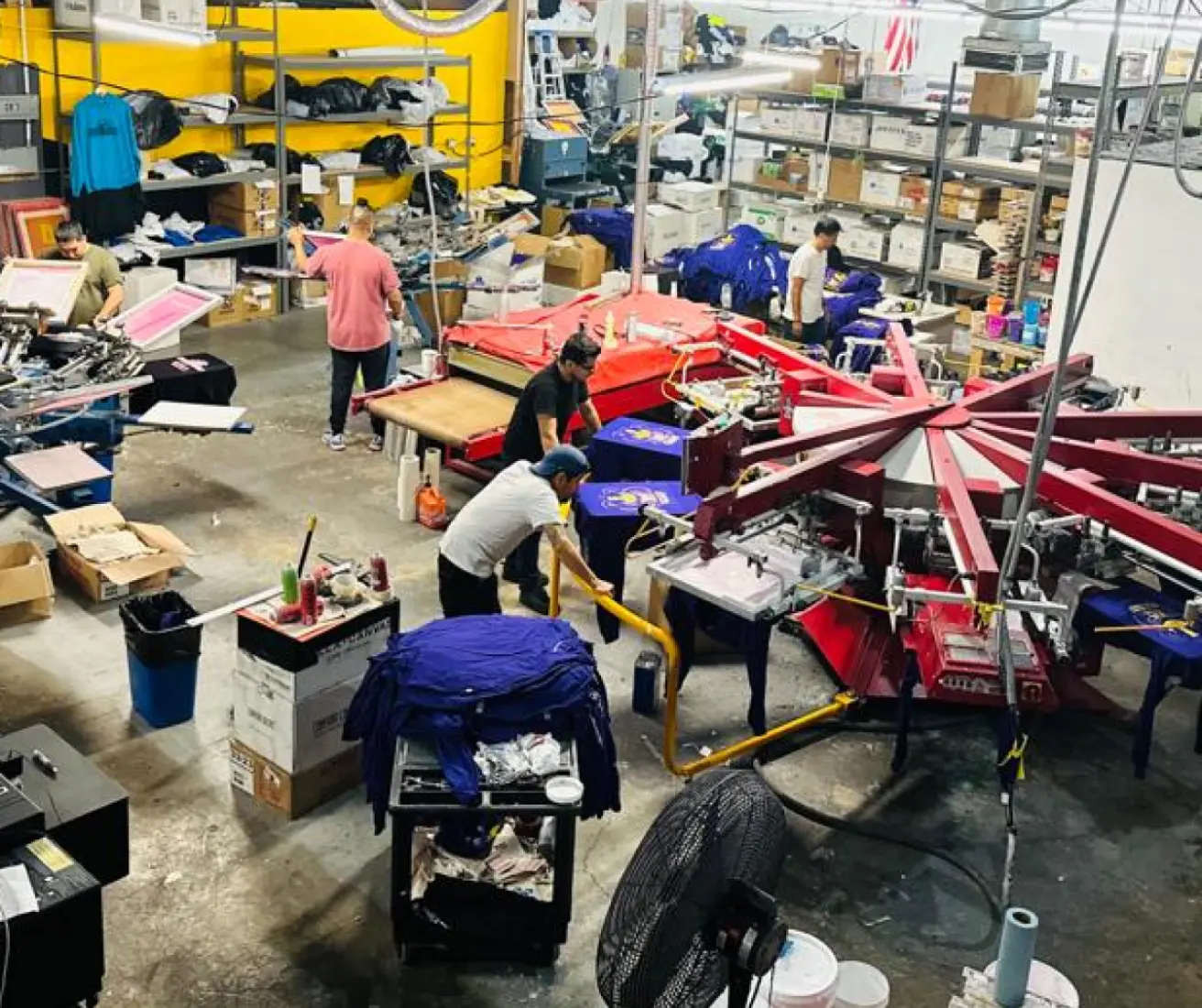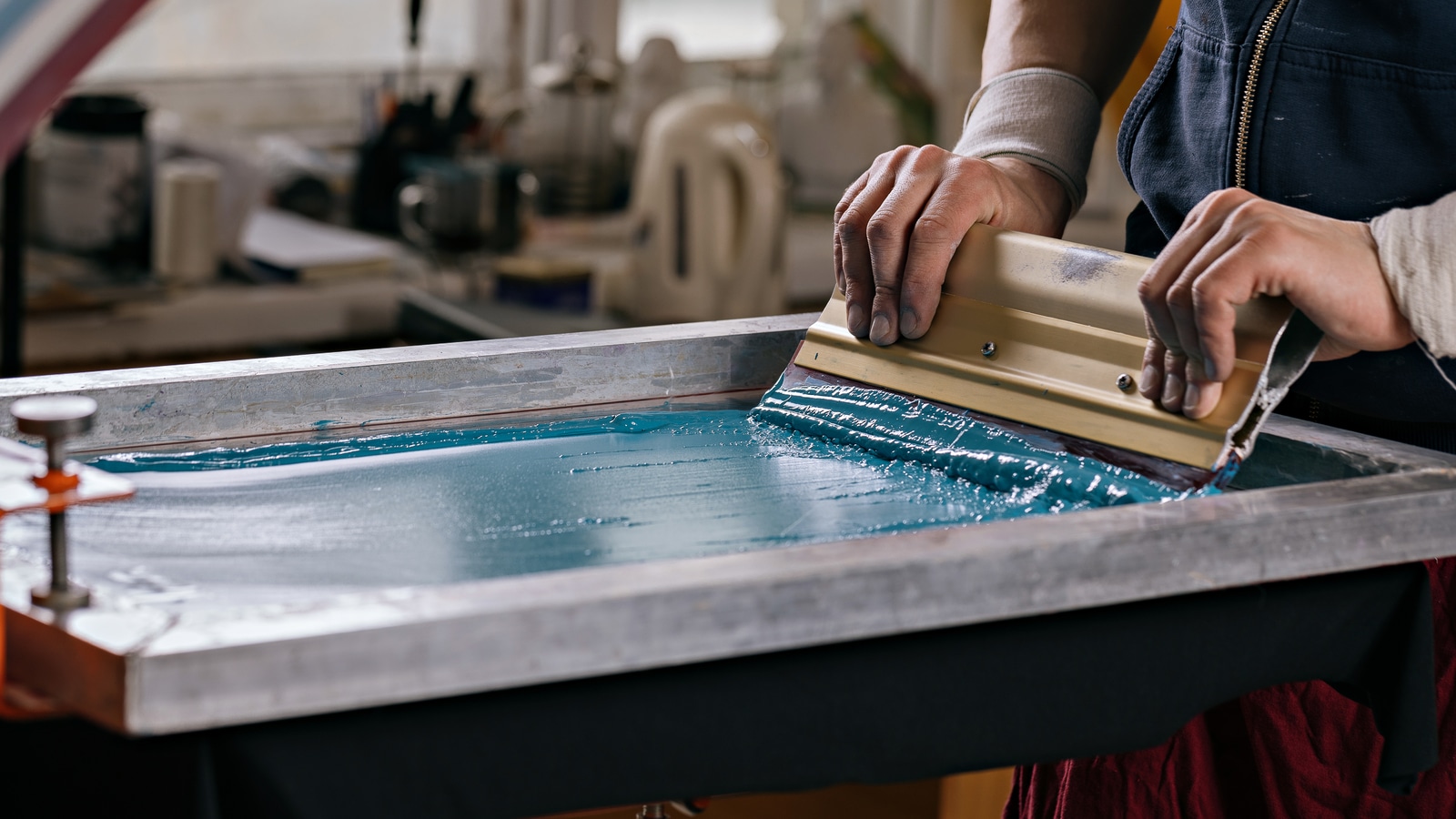Silk Screen Printing for Bold and Lasting Designs
Wiki Article
Screen Printing Uncovered: Whatever You Required to Know Concerning T-Shirt and Garment Printing Techniques
Display printing is a fascinating technique that incorporates art with strategy, providing countless opportunities for creativity. All set to check out the important elements that make display printing an art kind?
The Essentials of Screen Printing: Just How It Works
When you plunge right into screen printing, you'll find it's both a scientific research and an art. At its core, screen printing involves developing a pattern, or screen, that enables ink to pass via just in certain areas.Setting the display over the textile, then use a squeegee to push ink through the display onto the garment. Each action is important, and mastering them will elevate your screen printing skills, changing basic garments into special, expressive pieces.
Sorts Of Display Printing Strategies
When you comprehend the essentials of screen printing, it's time to discover the numerous methods that can raise your styles. One prominent approach is typical display printing, where ink is pressed via a stenciled screen. This strategy is fantastic for bold, vibrant shades. There's water-based ink printing, which provides a softer feeling and is environmentally friendly, yet it requires a different technique to healing.One more alternative is plastisol printing, known for its durability and vibrant shades, making it a favorite for numerous brands. Experiment with halftone printing to create gradient effects and complex designs.
Important Tools for Display Printing
To achieve spectacular outcomes in screen printing, having the best equipment is fundamental. You'll need a tough screen printing frame, which holds the mesh that moves your style onto the garment. Next off, purchase high-quality squeegees; these are crucial for applying ink uniformly across the display. You'll likewise require a great exposure system to create your displays, along with a washout booth for cleansing them after usage. A trusted warmth resource, like a conveyor clothes dryer or heat press, is crucial for treating your prints to ensure long life. Don't fail to remember a proper work area, furnished with tables and storage for your materials. Safety gear, such as gloves and masks, will certainly maintain you secure from chemicals and inks. With the right devices, you'll be well on your way to producing professional-quality prints.Selecting the Right Inks and Materials
When picking inks and materials for display printing, you require to consider the kind of ink that functions best for your job. Think of textile compatibility to ensure your styles look wonderful and last long. Explore green ink choices to make your printing process more sustainable.Types of Display Inks
Picking the right display ink is crucial for achieving lively, resilient prints that meet your job's demands. There are a number of kinds of display inks to take a look at. Plastisol ink is prominent for its versatility and simplicity of usage, providing excellent shade opacity on dark fabrics. Water-based ink, on the other hand, uses a softer feel and is environmentally friendly, making it perfect for those wanting to reduce their ecological influence. Discharge inks remove dye from the fabric, resulting in a soft, classic appearance but require certain handling. Finally, specialized inks, such as glow-in-the-dark or metal, can include unique results to your designs. Evaluate your job requirements and pick the ink that aligns best with your wanted end result.
Material Compatibility Factors To Consider
Comprehending material compatibility is vital for attaining top notch screen prints, especially given that various products respond distinctively to numerous inks. When picking inks, consider the material type-- cotton, polyester, or blends. For cotton, water-based inks function well, offering soft qualities and breathability. Polyester, on the other hand, frequently needs plastisol inks for far better attachment and vibrant colors. If you're publishing on blends, you might require to use a combination of both kinds. Always examine your inks on example material to assure they stick properly and maintain color stability. In addition, keep in mind that material weight and texture can impact the final result, so selecting the best ink and material combination is important for your task's success.Eco-Friendly Ink Options
Environmentally friendly inks are coming to be a prominent selection for screen printers who desire to reduce their ecological influence while keeping top quality. When selecting inks, consider water-based inks, which are much less unsafe and much easier to cleanse up contrasted to conventional solvents.Furthermore, search for inks made from renewable sources, such as soy or vegetable-based choices. By selecting the ideal inks and products, you'll not just develop spectacular designs however also contribute to a more lasting printing process. Make the switch, and your prints will certainly show your dedication to the atmosphere!
Preparing Your Style for Display Printing

Submit Style Needs
To assure your layout looks vivid and sharp on material, you'll need to pay close interest to submit format needs for screen printing. Make sure your design has a transparent history to avoid undesirable white edges on your silk screen printing prints. Keep shade modes in mind; CMYK is standard for screen printing, so convert your RGB creates as necessary.Color Splitting Up Strategies
Shade splitting up is a crucial step in preparing your design for display printing, and understanding it can greatly boost your print top quality. You'll require to break your design into private colors, as each shade calls for a separate display throughout printing. This accuracy not only assures accurate shade representation however additionally streamlines the printing process.Resolution and Dimension
Accomplishing the most effective cause display printing starts with guaranteeing your style has the appropriate resolution and dimension. Ideally, your art work must be at the very least 300 DPI (dots per inch) for sharp, clear prints. If you utilize reduced resolution, your end product may look amateur and pixelated.When it involves dimension, take into consideration the measurements of your print area. Layout your art work to match the final print size, ideally developing it in the actual dimensions you'll be publishing. By doing this, you'll avoid any type of unforeseen scaling problems.
Always inspect your style in both vector and raster layouts. Vector graphics can be scaled without shedding high quality, making them optimal for screen printing. Preparing correctly will guarantee your layout looks impressive on every garment!
Step-by-Step Screen Printing Process
Screen printing is a vibrant process that enables you to produce vivid styles on numerous surface areas. To get begun, you'll require a display, emulsion, and your chosen ink.Put ink onto the screen and make use of a squeegee to press the ink via the stencil onto the material. Raise the display thoroughly and allow the print completely dry. You've successfully display printed your design.
Tips for Effective Screen Printing Projects
While you're diving into your display printing projects, keep in mind that prep work is essential to success. Beginning by gathering all your materials-- inks, squeegees, displays, and garments. A clean work area helps protect against unwanted mistakes, so clean up before you begin.Following, confirm your artwork is high-resolution and effectively sized for your garment. Test your screen for correct direct exposure and tidy it completely to avoid spots. When blending your inks, comply with the producer's standards to attain the ideal uniformity.
Throughout printing, apply also pressure with your squeegee for regular outcomes. Do not rush; take your time to confirm each print meets your criteria. After printing, let your garments completely dry totally prior to taking care of or packaging them.
Lastly, constantly maintain an example of your benefit future referral. By doing this, you can assess your progression and improve your methods over time. Pleased printing!

Regularly Asked Questions
The length of time Does It Take to Set up a Display Printing Work?
Setting up a screen printing task normally takes around half an hour to an hour. You'll prepare the displays, mix inks, and adjust journalism. The moment varies based upon complexity and experience, so remain arranged!Can I Print on Different Textile Keys In Utilizing the Very Same Technique?
Yes, you can print on various fabric types utilizing the exact same strategy, but you'll require to change your inks and setups. Some textiles soak up ink differently, so exploring warranties the best results for each product.What Prevail Blunders to Prevent in Display Printing?
When display printing, avoid typical errors like making use of the incorrect ink, neglecting correct exposure times, or missing pre-press checks. Constantly test your arrangement and keep clean displays to assure high quality results each time.How Can I Correctly Clean and Keep My Display Printing Devices?
To effectively clean and preserve your screen printing equipment, you must routinely wash displays with appropriate solvents, examine mops for wear, and guarantee all devices are saved completely dry and dust-free. Uniformity protects against pricey repairs and boosts performance.Is Screen Printing Eco-friendly Compared to Other Approaches?
Display printing can be more eco friendly than other methods, especially if you use water-based inks and eco-conscious materials. By choosing sustainable supplies and practices, you minimize waste and minimize your effect on the world.Screen Printing Uncovered: Everything You Need to Know About T-Shirt and Garment Printing Strategies
At its core, display printing entails creating a pattern, or display, that enables ink to pass with only in specific areas. Placement the screen over the textile, after that utilize a squeegee to push ink through the display onto the garment. One popular approach is conventional screen printing, where ink is pressed via a stenciled display.When choosing inks and materials for screen printing, you require to take into account the type of ink that works best for your task.
Report this wiki page